Here are the effective Strategies for Controlling thrips in English Cucumber Cultivation
Introduction
Thrips are a major pest in English cucumber cultivation, causing significant yield losses through direct feeding and by transmitting viral diseases such as Tomato Spotted Wilt Virus (TSWV). These tiny, sap-sucking insects thrive in warm, dry conditions and are particularly challenging to manage due to their rapid life cycle and ability to develop resistance to insecticides.
In India, where cucumber is widely grown in open fields and protected structures like polyhouses, an integrated pest management (IPM) approach is essential to effectively control thrips populations. This blog outlines five effective strategies combining physical, biological, and chemical control methods to keep thrips infestation under check.
1. Physical Control Methods
Physical methods are the first line of defense in an integrated pest management program. These non-chemical approaches help reduce thrips populations before they reach damaging levels. It is a kind of preventive mechanism against thrips.
a) Reflective Mulching
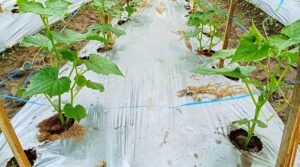 Image Credits : Epic Gardening
Image Credits : Epic Gardening
- we can use reflective silver or aluminum mulches on the soil surface to disrupt thrips movement and reduce their ability to locate host plants.
- This method is particularly effective in early crop stages when plants are more vulnerable to thrips attacks.
b) Sticky Traps for Early Detection
 Image Credits : Dreamstime
Image Credits : Dreamstime
- Blue and Yellow Sticky Traps: Blue traps are more attractive to thrips, while yellow traps attract both thrips and whiteflies. In my opinion, blue coloured traps are effective than yellow especially for thrips.
- Sticky traps need to be installed 30 cm above the canopy and increasing the number of traps as the crop grows.
- Regular monitoring helps in early detection and prevention of thrips.
c) Protective Barriers and Netting
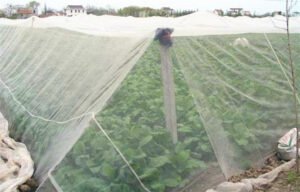 Image Credits : Tuohua
Image Credits : Tuohua
- Insect nets (50 % mesh) needs to be installed around the crop in the field to prevent thrips entry.
- Sealing all openings and doors in protected cultivation/polyhouses will help us in maintaining an insect free environment.
2. Biological Control Methods
Using natural enemies of thrips is an eco-friendly and sustainable approach to pest management.
a) Predatory Mites (Amblyseius spp.)
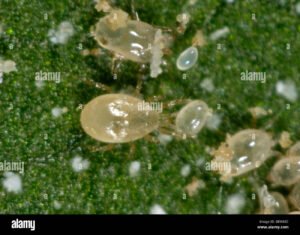 Image Credits : Alamy
Image Credits : Alamy
- These mites feed on thrips larvae and reduces thrips population when introduced early.
- Recommended dose: 100-150 mites per plant.
- Highly effective in polyhouse conditions.
b) Beauveria bassiana (Entomopathogenic Fungus)
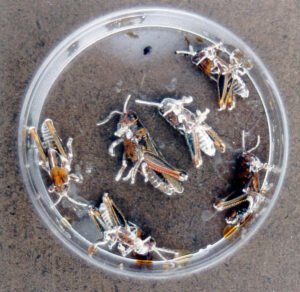 Image Credits : Wikipedia
Image Credits : Wikipedia
- This biological insecticide infects thrips and causes mortality within a few days.
- It works best under humid conditions and should be sprayed early in the morning or late evening.
- Recommended dose: 2–5 g per liter of water.
c) Minute Pirate Bug (Orius spp.)
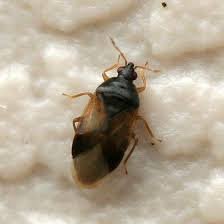 Image Credits : Bug guide
Image Credits : Bug guide
- These predatory bugs actively hunt thrips adults and larvae.
- Releasing 5–10 Orius bugs per square meter in polyhouse conditions.
3. Cultural Control Methods
Cultural practices reduce the pest’s habitat and prevent population buildup.
a) Timely Removal of Weeds and Alternate Hosts
- Thrips breed on weeds such as parthenium, amaranthus, and chickweed.
- Keeping the field weed-free minimizes the presence of alternative hosts.
b) Intercropping and Trap Crops
- Planting marigold as a trap crop attracts thrips away from cucumbers.
- Onion and garlic intercrops release sulfur compounds that will be helpful to repel thrips.
c) Proper Irrigation and Humidity Control
- Thrips prefer dry conditions; maintaining a relative humidity of 70–80% in polyhouses can minimize thrips population.
- Spraying water on crop foliage during high thrips infestation can physically dislodge them.
4. Chemical Control Methods
When thrips populations exceed economic thresholds, selective insecticides should be used. However, frequent rotation of insecticide groups is necessary to prevent resistance.
a) Preventive Spray (At Early Crop Stage)
- Azadirachtin 1500 ppm (Neem Oil) at 5 ml per liter acts as an antifeedant and reduces egg laying.
- Spinosad 45 SC (0.2 ml per liter) is a biological insecticide with excellent efficacy against early-stage larvae.
b) Insecticide Combination for Moderate Infestation
- Thiamethoxam 25 WG (0.3 g per liter) + Spinosad 45 SC (0.2 ml per liter)
- This combination targets both larvae and adults
- Should be applied at weekly intervals if thrips activity persists.
c) Control at Severe Infestation
- Emamectin benzoate 5 SG (0.4 g per liter) + Acetamiprid 20 SP (0.3 g per liter)
- This combination provides a dual mode of action: contact and systemic effects.
- Avoid spraying during peak pollination time to protect beneficial insects.
d) Time and Method of Spray
- Early morning and late evening are ideal spray times for better results.
- Silicone-based spreader/stickers will enhance insecticide penetration into flower buds.
5. Resistance Management and Sustainable Practices
Over-reliance on chemical control leads to resistance development. Here’s how to manage it:
a) Rotation of Insecticides
- Rotate insecticides with different modes of action such as neonicotinoids, spinosyns, and avermectins to prevent resistance.
- Example rotation:
- Spinosad → Thiamethoxam → Emamectin Benzoate → Fipronil
b) Avoid Tank Mixing Pyrethroids
- Pyrethroids (e.g., lambda-cyhalothrin) are ineffective against thrips and may kill beneficial insects.
c) Use of Adjuvants
- Adding non-ionic surfactants improves spray coverage and insecticide efficacy.
Conclusion
Controlling thrips in English cucumber requires a well-planned Integrated Pest Management (IPM) approach. Farmers can achieve effective control by combining physical barriers, biological control, cultural practices, and selective insecticides while following proper resistance management strategies.
By adopting these five key control methods, cucumber growers can reduce thrips infestations, improve crop health, and enhance yield quality without causing excessive pesticide buildup in the environment.
For best results, farmers should regularly monitor thrips populations, adjust control methods based on infestation levels, and seek guidance from local agricultural experts. Implementing these strategies will lead to sustainable and profitable cucumber product
